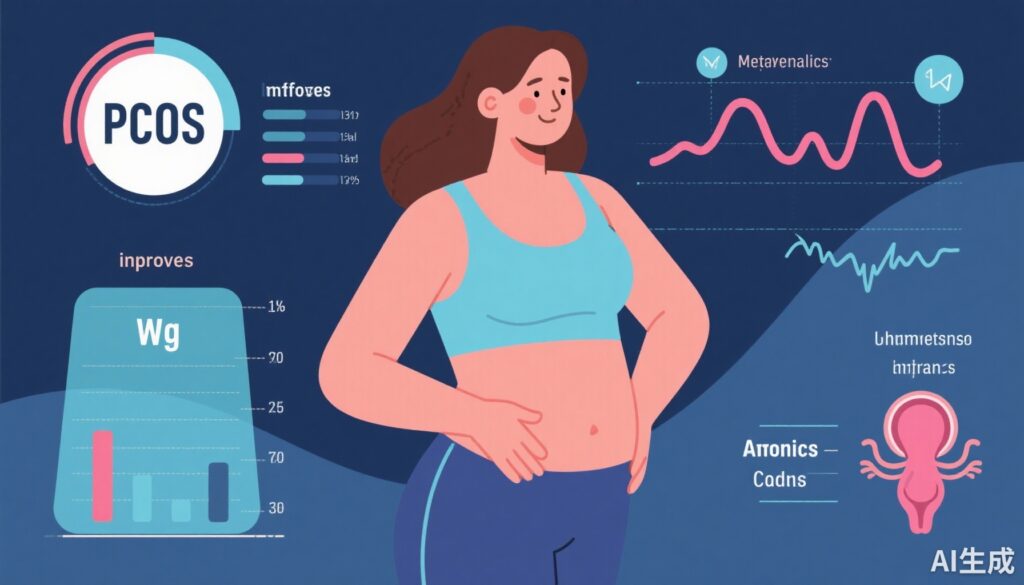Highlight
- Combination therapy of semaglutide and metformin significantly decreases body weight, BMI, and waist-to-hip ratio versus metformin alone in overweight/obese women with PCOS.
- Greater improvements in testosterone levels, visceral adiposity, and inflammatory marker CRP were observed with combination therapy.
- Combination therapy enhanced menstrual cycle recovery and markedly increased natural pregnancy rates during follow-up.
Study Background and Disease Burden
Polycystic ovary syndrome (PCOS) remains one of the most prevalent endocrine disorders affecting reproductive-aged women globally, characterized by hyperandrogenism, ovulatory dysfunction, and polycystic ovarian morphology. Overweight and obesity exacerbate PCOS metabolic and reproductive abnormalities, compounding insulin resistance and inflammation. Currently, metformin is widely used to improve insulin sensitivity and reproductive outcomes, but its effects on weight loss are modest. Glucagon-like peptide-1 receptor agonists (GLP-1 RAs), such as semaglutide, have demonstrated potent weight reduction and metabolic benefits in type 2 diabetes and obesity cohorts. This study addressed the unmet clinical need for effective combined pharmacologic interventions targeting both metabolic dysfunction and reproductive abnormalities in overweight/obese PCOS women.
Study Design
This prospective, randomized, controlled, open-label trial enrolled 100 overweight or obese women diagnosed with PCOS per Rotterdam criteria. Participants were randomized equally into two treatment arms:
– Metformin monotherapy (MET): 1000 mg twice daily (BID) for 16 weeks
– Combination therapy (COM): Metformin 1000 mg BID plus semaglutide 1 mg once weekly (QW) for 16 weeks
Primary endpoints included changes in anthropometric obesity-related measures (body weight, body mass index [BMI], waist-to-hip ratio [WHR]) assessed at baseline and Week 16. Secondary endpoints evaluated alterations in reproductive hormones (including total testosterone), glucose and lipid metabolism indices, inflammatory marker C-reactive protein (CRP), and Chinese visceral adiposity index (CVAI).
From Week 16 to Week 40, all participants received metformin 1000 mg BID monotherapy to assess subsequent natural pregnancy rates as a long-term reproductive outcome.
Key Findings
The study achieved a completion rate of 80%, with 80 participants finishing the protocol (40 per group). Outcomes after the initial 16-week intervention phase highlighted several key differences between groups:
– Weight and Anthropometric Measures: The COM group experienced a significantly greater mean weight loss of 6.09 ± 3.34 kg compared with 2.25 ± 4.27 kg in the MET group (P < 0.01). Correspondingly, BMI and WHR reductions were more pronounced in the combination arm (P < 0.01 for both).
– Metabolic Parameters: The combination therapy group demonstrated significant improvement in insulin resistance markers indicative of better glucose homeostasis. Notably, Chinese Visceral Adiposity Index (CVAI), which correlates with visceral fat burden, declined more in the COM group, suggesting beneficial effects on central obesity.
– Reproductive Hormones and Cycle Recovery: Testosterone levels decreased more significantly in the COM group (P < 0.01), consistent with amelioration of hyperandrogenism. Menstrual cycle normalization—an important clinical outcome—was achieved more frequently with combination therapy.
– Inflammation: Serum C-reactive protein (CRP) levels, representative of systemic inflammation, were notably reduced in the COM group compared to MET alone.
– Pregnancy Outcomes: During the 24-week post-intervention period with metformin monotherapy, natural pregnancy rates were significantly higher in the COM group (35%) than the MET group (15%) (P < 0.05).
Safety data indicated tolerability consistent with known profiles of semaglutide and metformin, with no new adverse safety signals reported.
Expert Commentary
This rigorously conducted randomized trial provides clinical evidence reinforcing the synergistic benefits of combining a GLP-1 receptor agonist with metformin in overweight/obese women with PCOS. By leveraging semaglutide’s potent weight-reducing and insulin-sensitizing effects, the combination improves key metabolic and inflammatory parameters, which likely underlie observed enhancements in reproductive function, including menstrual regularity and fertility rates.
The inclusion of the Chinese Visceral Adiposity Index enhances assessment sensitivity for visceral fat changes beyond traditional anthropometrics, connecting metabolic improvement to adiposity localization—a critical pathophysiologic component in PCOS.
These findings align with emerging guideline discussions advocating multimodal approaches targeting both metabolic and reproductive manifestations of PCOS, particularly in patients with excess weight. Mechanistically, GLP-1 RAs may exert direct effects on hypothalamic-pituitary-ovarian axis regulation and reduce systemic inflammation, potentially explaining reproductive improvements beyond weight loss alone.
However, generalizability might be limited by the single-center design and relatively short intervention period. Larger, multicenter trials with extended follow-up are warranted to confirm long-term reproductive and metabolic benefits and assess pregnancy outcomes comprehensively.
Conclusion
The combination of metformin with semaglutide represents a promising therapeutic advancement for managing overweight/obese women with PCOS. It produces significantly greater weight reduction and metabolic improvement than metformin monotherapy, accompanied by enhanced menstrual regularity and increased natural pregnancy rates. Incorporating GLP-1 receptor agonists in PCOS treatment paradigms may address critical gaps in managing this complex syndrome by simultaneously targeting obesity, insulin resistance, inflammation, and reproductive dysfunction.
Ongoing and future research should evaluate optimal dosing, safety in pregnancy, and cost-effectiveness to facilitate integration into clinical practice guidelines.
References
1. Chen H, Lei X, Yang Z, Xu Y, Liu D, Wang C, Du H. Effects of combined metformin and semaglutide therapy on body weight, metabolic parameters, and reproductive outcomes in overweight/obese women with polycystic ovary syndrome: a prospective, randomized, controlled, open-label clinical trial. Reprod Biol Endocrinol. 2025 Jul 26;23(1):108. doi: 10.1186/s12958-025-01447-3. PMID: 40713699; PMCID: PMC12297736.
2. Rotterdam ESHRE/ASRM-Sponsored PCOS Consensus Workshop Group. Revised 2003 consensus on diagnostic criteria and long-term health risks related to polycystic ovary syndrome. Fertil Steril. 2004;81(1):19-25.
3. Legro RS, Arslanian SA, Ehrmann DA, et al. Diagnosis and treatment of polycystic ovary syndrome: an Endocrine Society clinical practice guideline. J Clin Endocrinol Metab. 2013;98(12):4565-4592.
4. Wild RA, Carmina E, Diamanti-Kandarakis E, et al. Assessment of cardiovascular risk and prevention of cardiovascular disease in women with PCOS: a consensus statement by the androgen excess and PCOS society. J Clin Endocrinol Metab. 2010;95(5):2038-2049.
5. Garber AJ, et al. Consensus Statement by the American Association of Clinical Endocrinologists and American College of Endocrinology on the comprehensive type 2 diabetes management algorithm – 2020 executive summary. Endocr Pract. 2020;26(1):107-139.

